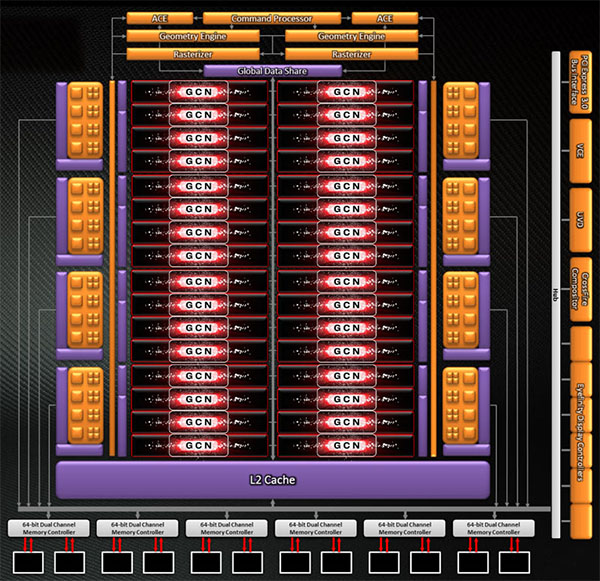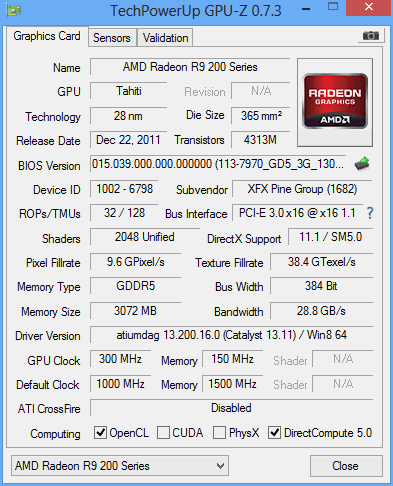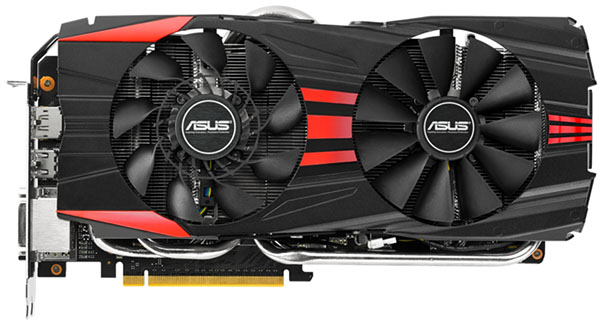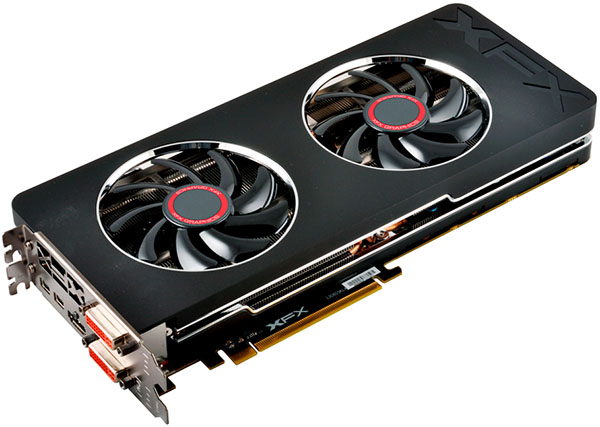AMD Radeon R9 280X, R9 270X, And R7 260X: Old GPUs, New Names
AMD is introducing a handful of new model names today, based on existing GPUs. Do the company's price adjustments make this introduction newsworthy, or will the excitement need to wait for its upcoming Radeon R9 290 and 290X, based on fresh silicon?
R9 280X: The Tahiti GPU’s Second (Or Third?) Lease On Life
I guess it depends whether you consider the Radeon HD 7970 GHz Edition a distinct product introduction. If so, then R9 280X is the third single-GPU graphics card sporting AMD’s complete Tahiti GPU.
When I wrote AMD Radeon HD 7970 GHz Edition Review: Give Me Back That Crown!, that card featured a base clock rate of 1 GHz that’d jump to 1.05 GHz under the effects of PowerTune with Boost. Otherwise, it employed Tahiti in its uncut form—with 2048 Stream processors, 128 texture units, 32 ROPs, and a 384-bit aggregate memory bus populated with 3 GB of GDDR5 at 6 GT/s. AMD slapped a 250 W maximum board power on the card and started shipping it at $500 (already down $50 from the original 7970’s launch).
The R9 280X’s specs are very, very similar. Its Tahiti GPU boasts the same 2048:128:32 configuration, with a 384-bit memory bus rocking 3 GB of GDDR5 that AMD says should operate at 6 GT/s. You’ll need to use the same six- and eight-pin connectors for an identical 250 W board power. The one notable difference is the 280X’s engine clock, which tops out at 1 GHz. As a result, you’ll notice the R9 280X performing slower in our benchmarks. Fortunately, there’s that price drop…
At $300, an R9 280X does battle against the GeForce GTX 760, mostly. I say mostly because the cheapest 770s are selling for around $400 (clearly too high to be in the same league), while the 760s are between $250 and $320. And since we already know the Radeon HD 7970 GHz Edition and GeForce GTX 770 are the cards that trade blows, well, AMD should be in a pretty strong position by the time we get to the end of our benchmarks.
To answer whether existing Radeon HD 7970 cards can be paired with the new R9 280X, yes, they work together. A quick Fraps-based test showed one 280X hitting 52.9 FPS in Battlefield 3 at 2560x1440. Dropping a 7970 GHz Edition next to the newer board pushed frame rates to 102.3 FPS. When it wasn't in use, the 7970 properly spun down according to AMD's ZeroCore technology.
We received two different takes on the R9 280X, neither of them conforming to AMD’s reference design.
Asus R9280X-DC2T-3GD5
The first card was Asus’ R9 280X DirectCU II TOP, an overclocked board with a GPU capable of up to 1070 MHz and GDDR5 memory at 6400 MT/s. According to Asus, it’ll sell this variant for $310, bundled with a power adapter and CrossFire cable.
Get Tom's Hardware's best news and in-depth reviews, straight to your inbox.
Beyond the tweaked specifications, Asus employs a non-reference PCB and oversized cooling to help manage power, thermals, and acoustics. The company says AMD’s reference 280X employs a five-phase (60 A/phase) PWM, while its own card features eight phases at 45 A/phase. This, along with claimed higher-quality power components, is supposed to benefit aggressive overclocking. Naturally, Asus bundles its GPU Tweak software for adjusting core clock, voltage, memory, power target, and fan speed (mostly settings you can tune in AMD’s OverDrive applet, except for voltage).
Although the R9 280X DirectCU II TOP is a dual-slot card, it’s also long and tall. The fan shroud stretches over the back of the PCB, imparting an 11.2” overall length. Further, a heat pipe coming out of the board’s top increases maximum height to 5.7”.
Display outputs include one dual-link DVI-I port, one dual-link DVI-D connector, HDMI, and a full-sized DisplayPort ouput.
XFX R9-280X-TDFD
XFX’s R9-280X-TDFD showed up next, based on a slightly different PCB. This is the one we benchmarked for our performance evaluation, if only because we were able to get its speeds and feeds first. An 850 MHz core clock rate accelerates up to 1 GHz when the thermal headroom allows. The memory tops out at AMD’s reference 6 GT/s, serving up to 288 GB/s of bandwidth.
Otherwise, the R9-280X-TDFD is a dual-slot board employing two axial-flow fans that do their job very quietly, but dump waste heat back into your case instead of exhausting it out the back.
Display outputs total five. You get one dual-link DVI-I port, one single-link DVI-D connector, HDMI, and two mini-DisplayPort outputs. Quad-card CrossFire configurations are supported across two bridges, though an extra-tall plastic frame surrounding the heat sink makes even a flexible ribbon connector difficult to attach.
Current page: R9 280X: The Tahiti GPU’s Second (Or Third?) Lease On Life
Prev Page Tahiti, Pitcairn, And Bonaire Show Up For An Encore Next Page R9 270X: Pitcairn Gets A Little Boost-
CaptainTom Wow what's with the AMD hate? As it stands they are doing the same thing Nvidia did except without the outrageous prices. The GTX 770 wasn't a great deal when the 7970 was $50 cheaper. Have fun trying to run BF3 with 2GB of VRAM...Reply -
slomo4sho Nothing revolutionary but better prices I suppose.Reply
The MSI R9 280X Gaming at $299 appears to outperform the GTX 770 at 1600P and is within margin of error at 1080P according to Techpowerup. Not a bad value at $100 less and still overclocks well:
http://www.techpowerup.com/reviews/MSI/R9_280X_Gaming/26.html -
jimmysmitty So long story short, if you have a HD7970GHz then these do nothing for you.Reply
Best to hold out till the reviews on the R9-290X I guess. But considering the specs I hope for at least 20% performance increases over a 7970. -
Shankovich What happened to Chris? I didn't see this kind of hate with all of the 700 series rebrands. Also, to the Canadians here, grab the $270 7970 GHz edition cards while you still can.Reply -
BigMack70 I don't like this new strategy AMD and Nvidia are taking of rebranding an old series at improved price points and then releasing only one new chip at a stupidly expensive price point.Reply
Are the days of (nearly) annual simultaneous full line GPU launches from $100-500 with a dual GPU chip to follow at $750-1000 really over? -
cangelini Hate? The R9 280X won an *award*. I think Tahiti at $300 is pretty much brilliant.Reply
I wrote one of the least flattering GTX 780 stories out there. I only identified a couple of situations where a Titan made any sense at all. And although the 760 *did* change the balance at $250, that card still didn't get an award. I liked the 770 for the simple fact that it delivered better-than-680 performance for close to $100 less.
The rest of AMD's new line-up is a lot like what exists already. Again, the 7870 is a better value than 270X. So what are you getting worked up over? The fact that I'm pointing out these aren't new GPUs? They're not. ;) -
Shankovich Ok Chris, I agree with you, sorry for the over reaction. But I really don't like how nVidia made price increases for some of the rebrands. Looking forward to your 290 and 290X reviews :DReply -
ingtar33 i'll take a 7950 at $129 thank you very much (or two). There is a major retailer selling them for that this week. Best buy all year. two 7950s for the price of one r9-280x? yeah... i'll do that all day every day.Reply -
tomfreak Radeon 7790 has true Audio = but not enabled boooooo = as a 7790 owner I somewhat disappointed :( . Anyone have any idea if we can crossfire 1GB 7790 and 2GB 260x?Reply -
net_nakul By the time a R9 380X comes out, the GCN Tahiti XT achitecture may be 4 years old (assuming end of 2015). AMD better come up with an awesome new architecture by then, considering the R&D time they have.Reply
That goes to you too Mr. NVIDIA




